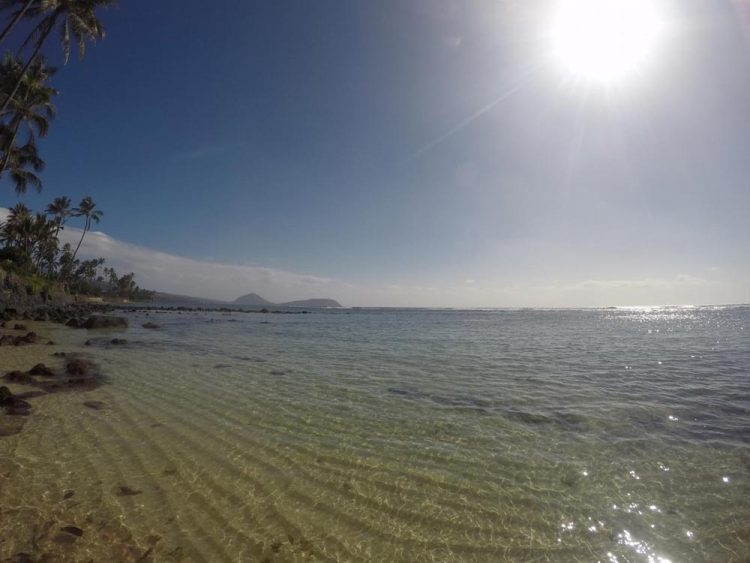New research shows how submarine groundwater affects coral reef growth

This is Maunalua Bay, Oahu, Hawaii. Credit: Florybeth La Valle, HIMB/ UH SOEST Usage Restrictions: Image may be used with appropriate caption and credit only
“SGD is common on nearshore coral reefs, especially in Hawai'i, so we set out to test how SGD affects coral reef growth in Maunalua Bay, O'ahu.” said Megan Donahue, associate researcher at the Hawai'i Institute of Marine Biology (HIMB) in SOEST and senior author of the study.
Two processes contribute to the overall growth of coral reefs: coral growth and bioerosion, the natural breakdown of coral reefs by reef organisms. To determine how SGD affects these processes, the research team outplanted small pieces of lobe coral on the reef flat in areas with a range of SGD and measured the changes in size over a six-month period.
They also put out blocks of dead coral skeleton across the same SGD gradients for one year to measure bioerosion rates. The blocks were scanned before and after the deployment with a micro-CT scanner, similar to a hospital CT scanner, to determine the amount of coral skeleton removed by bioeroding organisms in three dimensions.
In areas with high levels of SGD, it was a double whammy for coral reefs. Corals that were right next to SGD seeps performed poorly, likely due to the stress of too much fresh water.
“Additionally, we found that marine organisms responsible for bioerosion broke down the skeletal reef framework very quickly when exposed to high amounts of SGD,” said lead author Katie Lubarsky, who completed this research as part of her graduate degree in Marine Biology at UH Mānoa. “Many bioeroding organisms are filter feeders that perform better in high nutrient environments, so the high nutrient groundwater likely enhanced bioeroder activity. This indicates that high inputs of nutrient polluted SGD could favor reef breakdown and substantially slow down overall reef growth.”
To the researchers' surprise, SGD actually enhanced coral growth when the nutrient enrichment and freshwater from the groundwater was at low levels.
“Our results indicate that corals can thrive on SGD-impacted reefs if isolated from secondary stressors such as competition from seaweeds and sedimentation,” said Donahue. “Maunalua Bay is situated in a highly urbanized area, and the coral reefs in the bay have become degraded as the population has boomed over the last 50 years. But active management to reduce invasive algae and limit fine sediments could allow coral recovery in Maunalua Bay.”
“While the current study found that corals grow faster when exposed to low levels of SGD nutrient enrichment, coral cover remains extremely low on the Maunalua Bay reef flats,” said Nyssa Silbiger, study co-author and assistant professor at California State University, Northridge. “Our next studies will focus on how SGD and herbivory from fishes impact coral-algal competition, coral recruitment rates, and bioerosion rates.”
Media Contact
All latest news from the category: Life Sciences and Chemistry
Articles and reports from the Life Sciences and chemistry area deal with applied and basic research into modern biology, chemistry and human medicine.
Valuable information can be found on a range of life sciences fields including bacteriology, biochemistry, bionics, bioinformatics, biophysics, biotechnology, genetics, geobotany, human biology, marine biology, microbiology, molecular biology, cellular biology, zoology, bioinorganic chemistry, microchemistry and environmental chemistry.
Newest articles

A ‘language’ for ML models to predict nanopore properties
A large number of 2D materials like graphene can have nanopores – small holes formed by missing atoms through which foreign substances can pass. The properties of these nanopores dictate many…

Clinically validated, wearable ultrasound patch
… for continuous blood pressure monitoring. A team of researchers at the University of California San Diego has developed a new and improved wearable ultrasound patch for continuous and noninvasive…

A new puzzle piece for string theory research
Dr. Ksenia Fedosova from the Cluster of Excellence Mathematics Münster, along with an international research team, has proven a conjecture in string theory that physicists had proposed regarding certain equations….



